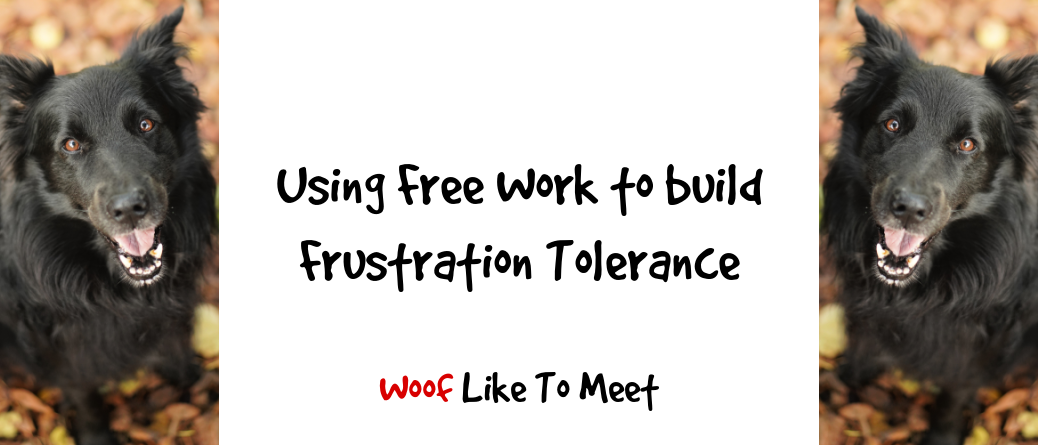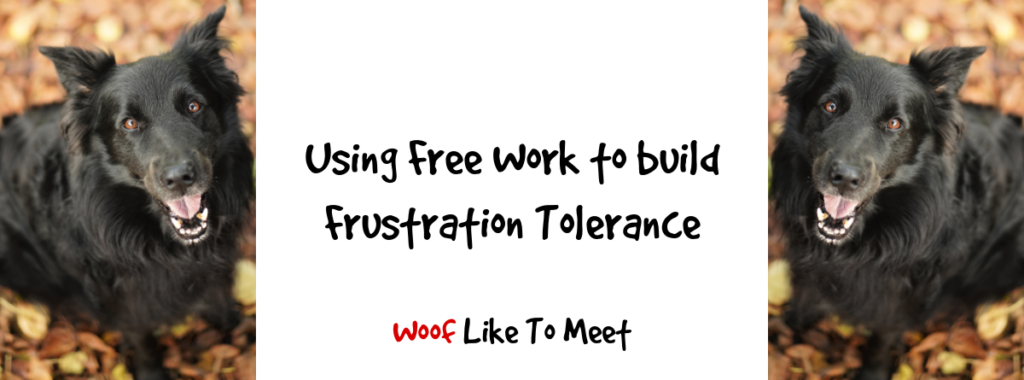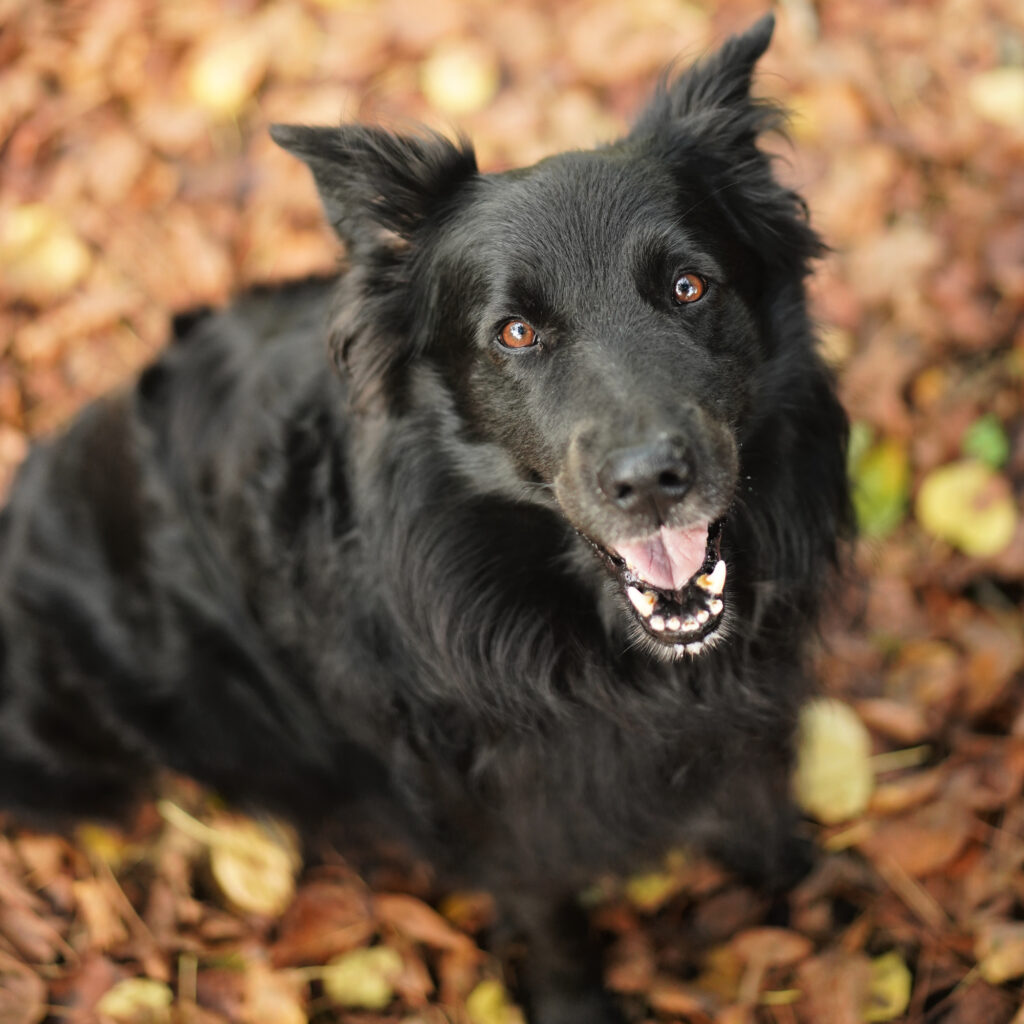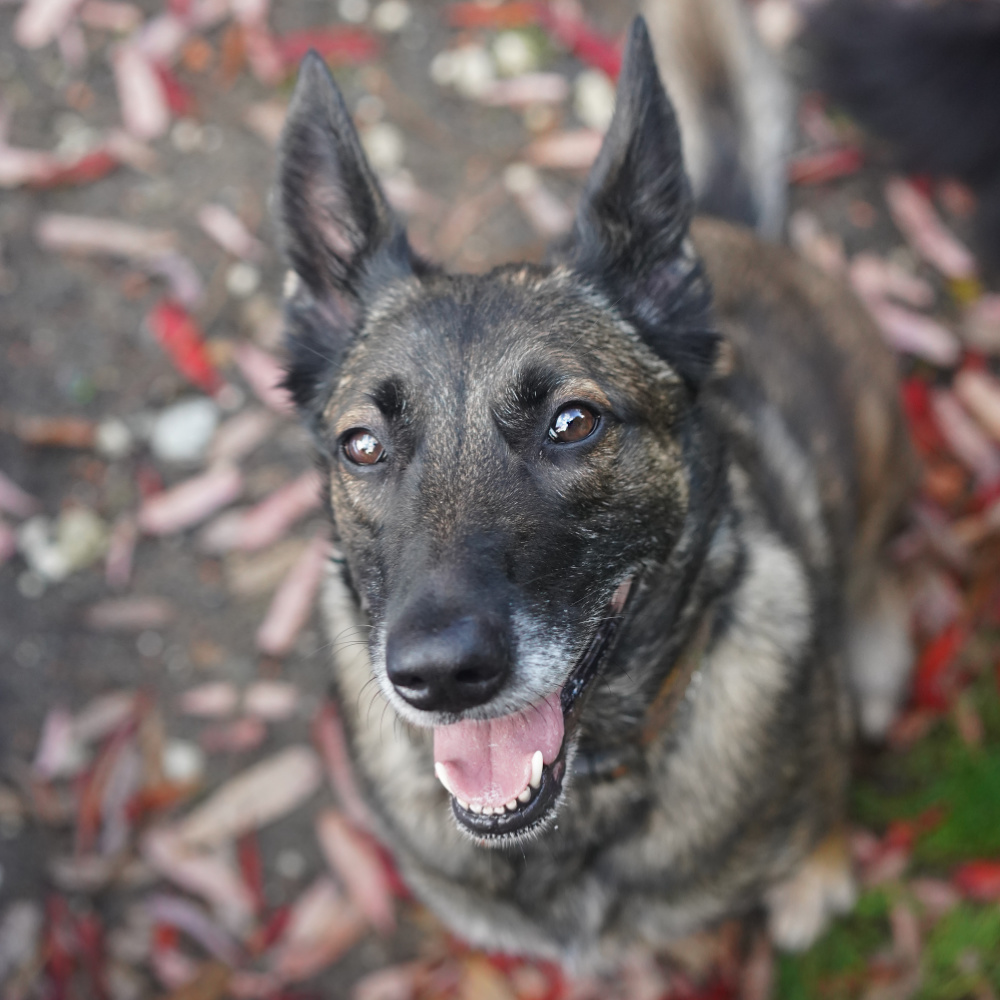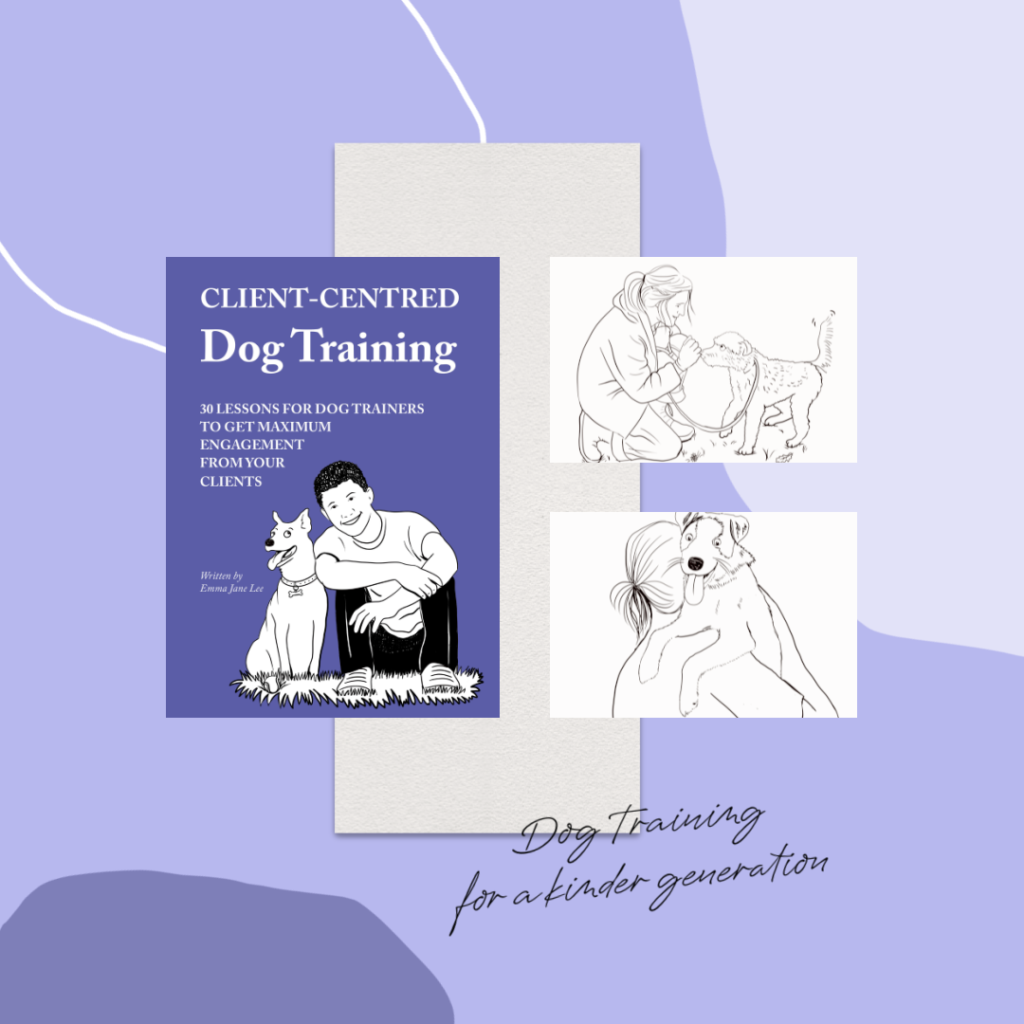We all want dogs who can cope with life’s minor setbacks and who can manage their emotions when they’re expecting something to happen.
When our dogs can’t regulate their own emotions and they can’t cope if they don’t immediately get what they want, they’re often living miserable lives in a state of semi-permanent irritation. They’re at risk of overarousal and difficult to train. It can lead to impulsive behaviour like door dashing and risk taking.
Worse still, it makes them hard to live with and it leads us to take shortcuts that are unsafe.
For instance, the other week, I was getting my dogs back in the car and another guardian pulled up at the secure field we use. She had three dogs in the back who were going bananas. The car park is safe but I hadn’t got my dogs back in the car just as she parked up and I know that she could see that. Because of the racket her dogs were making, she got straight out and opened her boot without checking if it was safe to do so. Just as she did, a car went past on the main road and one of her dogs ran off out of the car park.
I know why she hadn’t closed the car park gate. I know why she let her dogs out. I know that red-faced look and the sense of embarrassment.
I’d managed to get Lidy in the car, thankfully, because there’s no way she’d have coped with two over-excited dogs body slamming her as they did to Heston. He fell over and I had to help him stand back up again. The woman didn’t apologise. To be fair, I didn’t need her to. Apologies don’t change the fact that my boy had been knocked over by two large dogs.
Frustrated dogs mean that we make errors in judgement because we’re rushing to give them what they want straight away. Frustrated behaviours like jumping up, barking, and even grabbing or biting, can end really, really badly. The worst bites I’ve ever seen have been fuelled by frustration as the dog jumped and bit repeatedly because the guardian wouldn’t let the dog off lead to do what they wanted.
In 2019, Kevin McPeake and colleagues published a paper on frustration in dogs. It introduced a Canine Frustration Questionnaire from the University of Lincoln which you can find online and download. This is a very useful scale to help you unpick your dog’s behaviour. I would say that it’s sometimes better to drill down into the score and look at responses for the individual questions rather than simply looking at the average score.
Just as an example, when I rated one of my dogs on this scale, she fell within normal range… this from a dog who tried to eat her way out of my car once and tore all the rubber seals off the windows. Drilling down into the questions helped. If I were using this with a client, I’d be interested in the partly agree/partly disagree column: when does the dog do this behaviour?
Heston, for example, would happily fall way below average for most things. That dog copes magnificently with frustration.
All except one thing. Number 19. He’ll wait patiently for bowls being filled, for doors to be opened, to get in and out of the car… and he’s filled with joyous delight whenever there’s a walk on the cards. Question 19 was 5/5.
Lidy copes extremely well with most frustrating things as well. She scored more highly than Heston on average, but it was her response to other animals getting petting that tipped the balance. Not that hers is an offensive response… she just comes and politely nudges anyone petting another dog. It’s not like she shoves her way in.
The questionnaire is a very, very useful starting point for anyone concerned that their dog can’t cope when they’re restrained from getting what they want. It’s also useful to think about how your dog copes when expected rewards aren’t delivered in a timely fashion, or at all.
I firmly believe that frustration and impulse control are not the same things. I also believe that frustration and self-regulation when our expectations or desires are thwarted is a skill that is taught, not inherited. I also believe it’s tougher for some dogs because we’ve been breeding for looks not behaviour, and we’ve got a lot of dogs who just can’t cope when they don’t get their needs met.
And I also believe that giving in to dogs’ needs and letting them wear themselves out in doing whatever they want to do the moment they want to do it is causing us huge problems. It doesn’t create healthy or robust dogs if we just meet their needs all the time.
Take frustrated destruction for example. If we just cater to the dog’s needs all the time, all that happens is that they get more and more frustrated and destroying things becomes more and more addictive. I know dogs who destroy all kinds of balls, tyres, chews and tug toys. These are the dogs who live with people who ask on social media if anyone knows any destruction-proof toys.
The problem is that letting our dogs destroy things or vent their frustration is that these are the dogs who end up in A&E because they’ve ingested toys. They also end up doing an enormous amount of damage to their teeth and sometimes to their own bodies. These are the dogs who can’t cope on lead so their guardians let them off to go and run up to all and sundry. They end up in fights. They destroy things when they have to wait for anything. They often gobble their food and harass guardians if they’re not quick enough providing it. They can’t cope if their family members get something they don’t and get in fights with doggy housemates because they’ve shoved their way in to get petting one too many times. They’re often policed or schooled by older dogs who are often exhausted from having to constantly manage the frustrated behaviours of another animal. These are dogs who end up in fights over trivial things and haven’t got the skills to modulate their reaction. They lunge on lead, pullling guardians over. Or they pull on lead so the guardian lets them off even though the dog has poor recall. If you’re so used to getting your own way, you’re not going to come back when your guardian calls you away from stuff you’d rather do instead. They eat their way through leads, doors and crates. They bite the lead. They grab. They can’t cope at all if they don’t get their needs met and often resort to loud, obnoxious or annoying behaviours when they depend on others to deliver.
Have I convinced you sufficiently of the inherent problems of letting your dog constantly get what they want? We’re just shaping more and more problematic behaviours.
This notion that if dogs let off steam or let it out is known as the hydraulic model of emotional regulation. Vent your spleen, feel better.
The trouble is that it was proved wrong in the 1940s. Some things build up, for sure. Like if you don’t drink for ages, you’ll get thirstier and thirstier. If you don’t eat, your hunger will build up over time.
Frustration may well result from unmet physiological needs like hunger, thirst or social needs like the need for play, contact or attention. We need to make sure that what the animal can’t access is not something that is a fundamental physiological, emotional or social need. That’s the first port of call. Analyse what’s going on and make sure that the dog is not unduly deprived of having their needs met. Do that and you may not get the ensuing frustration.
On the other hand, misunderstanding things like the need for physical activity or looking at dangerous and uncontrolled destruction as an imperative biological need leads us into tricky ground. You know… ‘I’m sorry, your Honour. I did a bad rape because no-one would let me have sex with them’… ‘I’m sorry, your Honour. I admit I blew up the Parliament buildings because I was just so frustrated when my MP ignored my emails.’
Likewise dogs. ‘I’m sorry, Laura. I ate your couch because you wouldn’t feed me at 2.30pm like I demanded.’
‘Sorry that you have to take me to the vet again because I swallowed a load of plastic packaging. Explain to me what irreversible neurological damage from ingested toxins is again?’
We need not to conflate basic physiological needs and rights with dangerous or antisocial behaviour. That’s self-regulation. It’s all about learning how to cope in ways that are not destructive or damaging to the self or destructive or damaging to others.
This is not to say I advocate bottling it up. I’m not asking for our dogs to become quivering wrecks because we deliberately torment them. I mean I tried to do a video of how well my dogs coped with frustration by offering them a treat and then withholding it, and their poor, disappointed faces made me so ashamed that I immediately gave them three times as many treats to make up for my cruelty.
We do need to know how to cope with frustration. Like children, our dogs need to be taught how to self-regulate and how to cope. This needs to be done in a careful, structured way so that we don’t cause any more frustration. It’s a fine art.
Nor is it simply a case of what’s sometimes called frustration inoculation. You know – giving dogs stuff that they deliberately can’t get, or can’t get easily – to build up their coping skills. This is sadly sometimes advocated for puppies who just don’t have the brain wiring to even contemplate coping. We need to teach coping skills for moments when we don’t get what we want or when we need to wait to get them, but we need to do so in a way that doesn’t involve flooding young puppies whose brains aren’t ready for it yet. This is also true for adolescent dogs whose brains are a bit scrambled as sex hormones kick in and social skills sometimes lose their edge.
I know because this is exactly why Heston struggled with Q.19. I shaped some pretty obnoxious pre-walk behaviours in my boy as a teenager.
I also know that there are reasons why Heston and Lidy scored so low in general on the Canine Frustration Questionnaire…
… I taught them that too.
Since frustration behaviours are often so big and often so noticeable, it’s pretty easy to shape them into something spectacularly annoying, like the lady with the three dogs in the boot of her car; I’m betting she also broke the speed limit on her way and that if she slowed down just one fraction, her dogs would have had an absolute meltdown.
Today, we look at using free work with frustration.
I’ve written in this post about other ways to teach self-regulation and build up coping skills.
You can also read in this post about why ignoring behaviours is not a helpful strategy.
In today’s post I take you through the first in applying strategies we looked at in the last post, building on Sarah Fisher’s application of free work in ACE Connections.
#1 Teach dogs to move away or disengage
A dog who you can’t remove toys or feeders from is a liability. If you can’t get your hands near the items you’re using, then you’ll also not be able to remove them from the dog should they start to destroy them or ingest them. If your dog struggles with frustration, don’t start free work until you have made sure they’re able to move away.
Chirag Patel’s Counting Game is an absolute gift for this. Not only can you use it to move dogs away from toys they’re beginning to destroy, you can also use it to build voluntary interruption.
Like all Skinnerian methods, this is a cued behaviour. What that means is that the dog has a choice. Either they can carry on with what they’re doing, or they can choose to interrupt and come get extras. I find it invaluable if the dog is becoming more and more aroused by the items in the free work session, it cues them to move away and calm down.
Quite often, I’ll add in the Counting Game, count out three or four and ask the dog for some other behaviours as well. I’m big on biofeedback at the moment, so teaching the dog to take a breath, to shake off, to stretch, these are all mechanisms that can lower arousal levels.
I want a secure and automatic response when I say ‘1… 2… 3…. ‘ because I need it to be a reliable and well-proofed activity that can mean I can move the dog away from food toys if these things are causing frustration or the dog is destroying.
#2 Start when the dog is calmest
Building in free work not long after the dog has had a walk or they’ve just eaten can make the most of that still small moment of calm. I try and make sure that it’s irregular, so it may be after breakfast on one day, or after dinner on another. Expectation is the mother of frustration and so doing things in a regular and predictable way can cause more problems than it solves. You don’t need to keep it unreliable: just make sure that you’re not building reliability in the first five sessions or so if your dog struggles to cope when waiting for things. Quite often, I’ll prepare the activities when the dog is otherwise occupied because trying to arrange free work sessions can take some time and frustrated dogs are quick to realise the signs that you’re setting it up.
Be mindful of overfeeding in one go, especially if your dog eats quickly. Also avoid doing free work right after a walk if the walk has raised their heart rate. We shouldn’t be contributing to the likelihood our dogs will suffer from a stomach torsion just to make the most of that tiny window of calm. I may even have been doing other exercises to build frustration tolerance before we even get to free work.
You can build up to putting in free work sessions to lower arousal levels when your dog is a master at self-regulation, but if you try to do it when they’re overaroused right from the start, you’re missing a trick. It is usually very calming in itself and if you structure it in this way, beginning free work may actually generate feelings of calm that can be really beneficial at lowering arousal.
#3 Don’t ditch the bowl completely
Frustration depends on knowing what you’re supposed to get. When we don’t know what is supposed to happen and all our basic needs are met, then we’re not frustrated. Frustration depends on expectation. If removing a bowl would add to frustration, make sure you still put the bowl in there. No dog should have to work for all their food. Make a good portion of it stress-free and keep it that way.
If you eventually go to a majority of food use through toys, training and feeders, great. However, if your dog expects a bowl, then make sure they get one.
#4 Start with scatter feeding
I can’t tell you what a gift scatter feeding is for the frustrated dog as long as you set it up carefully.
Firstly, make sure the dog doesn’t see you preparing or doing the scattering. Make sure that you scatter feed on clean grass that hasn’t just been cut but is a clean space. Use strong smelling food to start with in relatively large pieces. I tend to use a tiny centimetre cube of sausage or cheese cut into quarters or eighths. On the first trial, I’ll put them where they’re clear, visible and relatively densely packed.
Then lead the dog to the place with the food.
Foraging in this way has built-in periods of frustration following the consumption of one morsel and the finding of the next. Also, if you use strong-smelling food then the smell will linger and you won’t find that sudden burst of annoyance when the food is all gone.
If your dog is likely to eat stones or grass because they are frustrated around food, then by all means use a large foraging mat or snuffle mat, but put the treats so that they are visible on the top. Do not bury them in the fabric. I’ve known dogs who couldn’t cope with frustration and whose guardians felt concerned that their dog might suddenly turn into a dog who eats stuff off the floor (they don’t, but I understand concerns aren’t always logical) who used a snuffle mat only for the dog to start grabbing and eating the fleece fabric in frustration. Grass is much better for that and it’s not likely to cause a blockage in the same way.
Once you’ve had a few trials, make the pieces smaller and further between. Finely grated and thinly distributed cheese tends to be much more of a challenge, particularly if you use cheese that doesn’t have a strong odour.
Graduate to a much larger area with a small handful of less odorous food that is distributed very finely indeed. You can even start then to leave in other items like t-shirts or towels that your dog might previously have struggled to cope with.
#5 Pack the food loosely and distribute heavily at first
Whatever toys or feeding methods you’re using, if you pack them hard at the beginning, your dog will struggle. For dogs who’d chew, I use a black Kong of an appropriate size, fill it with dog biscuits and plug the opening with cream cheese. I mean you really want it so the food will spill out.
I find silicone snakes too much of a challenge and too easy to destroy to start with.
Kong wobblers can be good although you may need to kickstart it by pushing it around. They’re robust and they’re hard to carry about. Start with small, hard, round biscuits that will fall out easily.
Snuffle mats can be introduced by putting the food on top.
If you’re going to build up to wrapping treats in a towel, start by a treat under each corner. Then you can start scrunching up the towel and hiding treats in the ripples. Then loose wrapping. Then tight wrapping. Again, if you’re liberal with the food and it’s easy to get at, you’ll notice much less frustration
#6 Start with large pieces of food
It can be difficult for dogs, especially those with long noses, to locate food that either doesn’t smell strongly or isn’t big enough to see easily. We can also run the risk of giving them so much rich and smelly food that we end up giving the dog pancreatitis or colitis. Though I’m never usually a fan of floury biscuits with a long Best Before dates, adding a few in at the beginning can lower frustration instead of giving frustrated dogs ten tiny pieces to find.
Like everything for a frustrated dog, you need to stretch out the distance between anticipation of food and consumption of food gradually. Maybe the first time I start with ten large dog biscuits and two small pieces of chopped sausage, and over the next ten sessions, I move gradually to no large dog biscuits and ten tiny pieces of chopped sausage. You need to manage the levels of difficulty at each stage.
#7 Move to sparse distribution and more tightly packed food
If you’re using scatter feeding, pickpocket or snuffle mat, start heavy and work towards thinning that out. If you start with a hundred pieces over five toys and move to twenty pieces over fifteen toys, you’re shaping your dog’s ability to cope with decreasing reinforcement. Remember that frustration isn’t just about thwarted desires but also about reduction and delay in reward. Start high and reduce. Make it easy and stretch out the work the dog needs to do between each station.
For this reason, tightly packed feeders can be frustrating because it’s difficult to get the food out. If you’ve started with a Kong that was loosely packed with round dog biscuits and then plugged at the top with cream cheese, peanut butter or mashed banana and you gradually make it harder to get food out, that can help your dog naturally build up the skills to cope.
For instance, adding a little cooked meat to the biscuits will make the biscuits roll around less. They are more challenging to get out. Adding a half teaspoon of cream cheese as you go will also make biscuits stick together and become more difficult to remove. As you make it more and more complex, you can build up to more sticky and liquid contents that you can also freeze. My dogs won’t tolerate a frozen Kong, but plenty will. Unsugared apple juice, unflavoured gelatin, kefir or onionless gravy can easily be poured in over biscuits or meat if you temporarily plug the bottom hole, and then you can freeze it if you wish. Just make sure you unplug the hole at the bottom before the dog gets it, so that the Kong doesn’t injure the dog.
#8 Build up to robust and noisy toys
Since these activities are designed to give your dog a structured programme that builds up their ability to cope when they get less than expected or when they can’t get it immediately, you should leave out noisy or robust toys at first. Some dogs absolutely love slamming around a Kong wobbler or an empty plastic bottle with treats inside and if you have one of those dogs who likes to destroy things, this can be a lot of fun. However, putting them into the programme too early on can be disasterous. Skills first, then challenge.
#9 Build up to more complicated puzzles
One of the toughest dispenser toys I have is a Nose-it.
It’s not smooth and round like a Kong Wobbler toy. The opening has some kind of silicone lip. It’s noisy and it takes a lot of work. My spaniel Tilly once spent two hours trying to get a single cube of ham out of one. That is some tenacity. My other dogs would have long since given up.
Toys like this can be great for the final stages where your dog is coping with everything, not least because some toys like this might encourage them to give up, for a while at least.
It reminds me that I was trying to build a new website the other day. My computer was slow; The site was slow. It wasn’t intuitive. I couldn’t find the code I needed easily or quickly… I got up, took a break, left it and came back. That’s the stuff of self-regulation. I didn’t throw my laptop to the floor. I realised (a bit too late, admittedly) that I was getting angry and I took time out. Toys that don’t give out everything and are robust enough to handle being thrown about are the ultimate test in frustration.
They aren’t for beginners. This is Final Boss level frustration tolerance.
Mitigate it by putting easier toys around with less high-value food in, so that this naturally encourages the dog to gravitate first to the smell of the tough toy, move away to lesser value items, then come back.
I guess Final Final Boss level is where you can tolerate five challenging toys, but while that might be an exercise in zen level frustration regulation, it seems a bit mean to me.
#10 Build in interruption
Mostly I let my dogs just get on with free work. It’s free. The secret is in the name. But it can be useful for dogs who struggle to self-regulate to be asked to move away for a brief period of time before they are released to come back to it. It’s also a good way to build up your recall and release cues. For our average dogs, they have zero need for us to do this, but we need to remember that coping with frustration is a skill like any other and that it gets better with practice. Most dogs will not need us to ever get to this level, but it’s always a useful skill to have for ‘just in case’ moments.
Since Heston has been on medication, he has become somewhat of a stomach on legs. As a result, he discovered at the ripe age of nine that animal faeces are a magical impromptu buffet. Having used a few free work sessions to build up his recall skills around food items, it’s helped me enormously with being able to ask him to leave the fecal buffet table and come eat stuff that won’t give him a week of colitis and worms.
A final word
As I wrote that last paragraph, both of my dogs reminded me of the importance of these coping skills. It’s 14:20. I’m not doing dinner until 16:00. He’s just come to tell me that he’s pretty sure I’ve forgotten to feed them and he thinks it’s 18:00. I’m going to go and give him something to occupy him for a couple of hours. He is always hungry these days as a result of his medication and being overweight does his joints no good at all, so I have to be strict on his behalf.
I petted him and Lidy had her task of Hercules to complete: coping when another dog gets attention and she doesn’t.
Both of them went away disappointed. I’m a hard woman. I’ll end here so that I can take their minds off their needs since they’ve both gone to lie down again and that makes me sad that they’re such masters of coping.
However, I end by reminding you once more that some frustration is inevitable in life, but dogs who live in a constant state of frustration would do better to work with a qualified behaviour consultant to help them learn how better to cope. If your dog scored highly on the Canine Frustration Questionnaire, definitely ask a professional for support.
Just a reminder that if you’re a dog trainer, you can pick up a copy of my book in paperback or ebook form here. Thanks to all those of you who’ve left such kind reviews. I’m about 80% ready to get the follow-up to the editor.
And if you are a dog trainer, you may also be interested in the new course I just finished for the DoGenius. It’s titled Revolutions in Reactivity and it’s the business. 15 hours of material ALL about reactivity including practical guidance and new strategies to help dogs move on and find safety. I’m mad proud of it.

